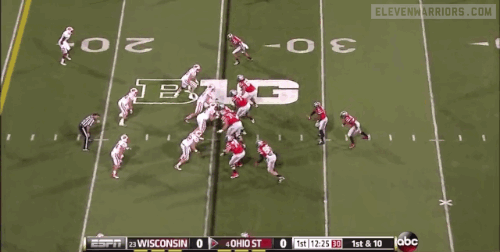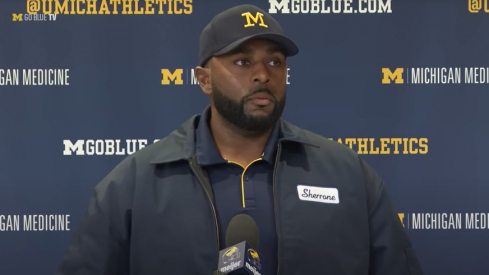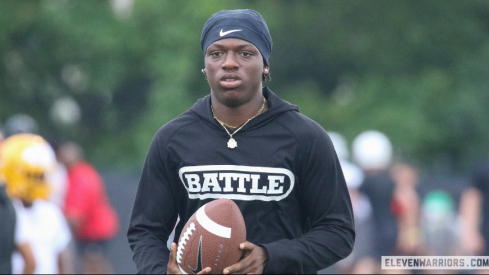
The Ohio State offense – in its first game at full strength – exhibited its potential but stalled late in its victory over Wisconsin. The Badgers' focus was taking away the inside run and containing Braxton Miller. This provided Ohio State opportunities on the edges and over the top, allowing the Buckeyes to build a comfortable lead.
But the Buckeyes wasted several opportunities in the third quarter. Perhaps because of this Urban Meyer decided to Tresselize the game's final quarter, playing field position and betting that Wisconsin could not string together the drives necessary to overcome its deficit. This strategy was successful but made it difficult for the Ohio State offense, as they ran headfirst into the Badgers' run-focused strategy.
Below I examine the Wisconsin 3-4 defense, Ohio State's offensive strategy, Miller and Carlos Hyde's return, and the Buckeyes' fourth quarter.
Plus One
Wisconsin defensive coordinator Dave Aranda's philosophy is to apply one additional defender in the box to stop the run. The Badgers' maintained their 3-4 look against the Buckeyes' 11 personnel, generally seeking to cheat their outside linebackers off Ohio State's slot receivers. The Badgers also often employed a modified Bear look, putting their defensive ends in a 4i technique.

In the secondary the Badgers operated from a cover 4 shell. At times they brought one safety in the box to play cover 3, particularly on third down. Harking back to last year, Wisconsin instructed their linebackers and safeties to play outside-in and contain Miller.
Lessons Learned
The Buckeye coaching staff correctly predicted that Aranda would employ this philosophy and corrected some of last year's mistakes. Ohio State split Jeff Heuerman out, utilizing 4 wide receiver sets to pull both Badger linebackers outside the box. The Buckeyes utilized heavy doses of play-action to take advantage of Wisconsin's run-first focus. Below the Buckeyes run a switch route off inside zone. Wisconsin's cover 3 safety came flying up to contain Miller, creating an easy two vs. 1 on the cornerback.

The Buckeyes also ran play-action off inverted veer, making the run action convincing by using the same power blocking. Wisconsin's back seven focused upon containing Miller, opening chunk yardage plays.

This overlapped with another Buckeye game plan. For the first time this year Ohio State used Dontre Wilson as a decoy in an attempt stretch the defense horizontally. This pulled Wisconsin's safeties outside in contain, creating opportunities inside and in the passing game. Note below how Wisconsin's safety backside safety flies up following Wilson.

Changing It UP
The Buckeyes also altered Miller's read on inside zone. Rather than reading to give or keep, Miller read the backside linebacker to give or throw a bubble screen.

The Buckeyes likely did so in response to how tight Wisconsin played their defensive ends and wide they played their linebackers. It would be difficult for Miller to keep and get outside the linebacker's contain. As such, if the backside linebacker stayed inside H receiver Corey Brown Miller would throw the screen.

But if the defender stayed wide Miller gave to Hyde.
Ohio State also mixed and matched their passing game based upon down and distance. In first and second down the Buckeyes responded to Wisconsin's aggressive safety support by attacking vertically off play action.

On third down Wisconsin often played cover 3. The Buckeyes responded with mid range throws, such as cover 3 beater all-curl or shallow crossing routes such as mesh. Below Brown does a nice job sitting down on mesh between the underneath cover 3 defenders.

Slow Down
Ohio State's offense slowed down as the second half progressed, however. Part of this was self-imposed mistakes. Ohio State's first four drives of the second half all entered Wisconsin territory but only resulted in seven points. What happened on the other three drives?
- Devin Smith dropped a potential touchdown pass.
- On 4th and 1 the Buckeyes ran a six man power play into an 8-man front. Chris Borland came through unblocked and stufed Hyde, resulting in a turnover on downs.
- On 3d and 4 from the Wisconsin 28, Corey Linsley missed a block, causing Miller to scramble and slip. This forced the Buckeyes out of field goal range.
Perhaps as a result, Meyer decided to play conservatively (and make no mistake, game management strategies rest with Meyer). The problem was that the decision played right into Wisconsin's game plan. In fact, Wisconsin doubled down. The Badgers played seven defenders in the box, utilizing cover 0 on the outside and daring Ohio State to throw.

In response, the Buckeyes attempted to use lead QB or speed option plays with Miller to minimize the numbers' differential. But Wisconsin still had an unblocked defender.

The Buckeyes faced the same problem on the aforementioned failed fourth down run. Wisconsin had eight defenders in the box against the Buckeyes' six-man blocking scheme for one back power.

The Buckeyes had no chance to block every defender. A tight zone dive play perhaps could have worked because of its quick hitting nature, but power takes longer to develop. Pulling guard Andrew Norwell had to choose between two unblocked linebackers in the hole, ending all chance of success.
In short yardage situations it is pointless to have wide receivers out wide if the defense is not going to respect the threat. The Buckeyes need to not predictably rely upon power and must be willing to take another approach.
The Buckeyes offensive line largely blocked the Wisconsin front well (with perhaps the exception of Borland) unless and until the Badgers were able to overwhelm the point of attack with unblocked defenders. The result was that the Buckeyes had difficulty gaining first downs to run out the clock, allowing Wisconsin to remain in the football game until the end.
The Prodigal Sons Return
As noted, Wisconsin marked the first game in 2013 that Ohio State's two primary threats from last season, namely Miller and Hyde, played together. Miller may be missing some of his lateral explosiveness due to his injury but demonstrated has improvement as a passer. He showed off his arm strength with deep vertical throws that were on a line and on point, but he also did a nice job making the correct reads against Wisconsin's third down coverage. Miller also showed better decisiveness scrambling when opportunities were available, getting up field for positive yards.
I have previously noted that Miller must improve on read plays, reading what the defense is providing rather than pre-determining whether to give or keep. That was largely a non-issue against Wisconsin, however, because Miller was generally asked to read on the inside zone or throw the bubble screen. He also generally made the correct reads on speed option. Miller's decision-making in the run and pass game was by no means perfect but both were an improvement, particularly given that this was Miller's first game in 2013 running the full scheme.
Hyde came out of the gate strong but tired late. This was noticeable in that he was too high in both his running and blocking. Meyer stated that they wanted to rely upon Hyde given Wisconsin playing their ends in 4i techniques, but acknowledged it was a mistake not playing Jordan Hall more. At this point it makes little sense to play Hall at H and take away reps from Brown and Wilson. But Hall is a versatile threat at tailback. What is more, a back such as Hyde should not play every series no matter who the second running back is, in the interest of keeping him fresh. Expect Hyde to get the majority of carries going forward but for Hall to play about every third series.
Falling Back on a Crutch
In hindsight, perhaps Meyer believes the offense became too conservative too early. But Meyer explained the rationale for his approach.
Here is what is going through our mind is that and Tom is obviously not the Lone Ranger there, but we felt for them to consistently throw the ball down the length of the field, we were playing plan to win which is field position football. Every time we had the ball was near the midfield area, and we have a very good punter, very good punt team. I trust our guys we are going to down that ball and we are going to make them drive it 90 yards.
They run the style of defense, now that I look back that they don't allow you to just run the clock. There's so many people packed in there that you can tell the way we scored our points were shots.
That's not the kind of you'll see all year they are not the kind of defense that's going to give methodical, running the ball, they force you to take the shots. That's why we try to run Braxton a couple times and spread them out and they work very, very well. That's what goes into the process. The end of the day, you're up three scorers against a team that supposedly can't throw the ball as well as they did and we made a decision that the way we lose that game is turn the ball over, and maybe style points, I heard something style points, we're not really concerned about that but we won the game.
Running the football into the teeth of Wisconsin's defense was perhaps a sub-optimal strategy but, as noted, the Buckeyes' output was as affected by their own mistakes as attempting to run out the clock.
Ultimately, in a tight game Meyer went back to what he did last season, which is run Miller. That is where Meyer will generally goes when the chips are down and he needs a play.
Even with the slow finish, the Buckeye offense was largely successful against Wisconsin, averaging .46 points per play.
With an important road game at Northwestern against a 4-2-5 over nickel defense this Saturday, Miller and Hyde should improve with a game under their belts. Their absence likely set back the coaching staff determining how to mix and match their personnel into a cohesive whole. Look for the Buckeyes to fine tune how they use players such as Hall and Wilson going forward.

